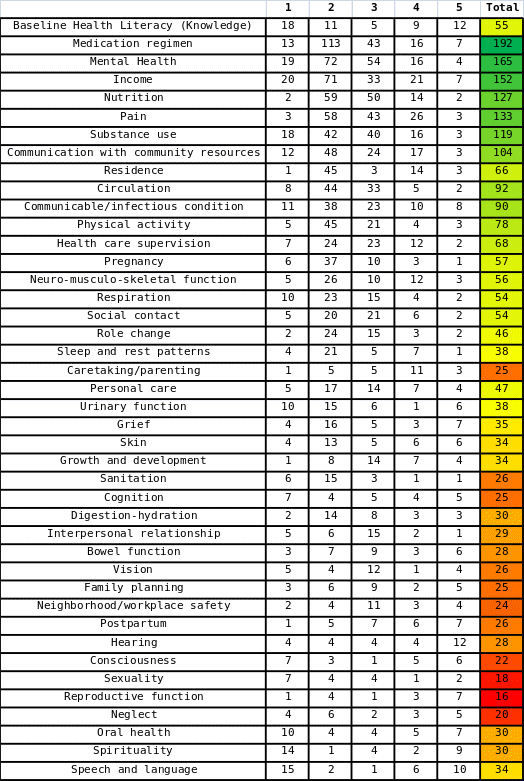
Discussion
Patterns
The above heat map was created based on the first option dataset. It focuses on assessing various health indicators, beginning with the overall health literacy and ending with specific issues such as spirituality and reproductive health. One may suggest that this dataset evaluates health of several patients or families living in one area, belonging to one category, or having similar diseases. In reference to the heat map, several issues become evident and some patterns should be discussed (Monsen et al., 2015). Before identifying patterns, it should be stressed that green color refers to the most positive evaluation, and red color means the most negative scores.
First of all, the heat map shows that all of the five participants have a relatively low level of health literacy, while their mental health and health regimen are rather appropriate. At the same time, nutrition, substance use, income, and pain categories may be integrated as the ones having similar high scores. It means that the selected patients have a high or middle income, eat healthily, and deny alcohol and drug abuse. Furthermore, according to the heat map, physical activity, communicable condition, and communication with community resources are ranged between 80 and 100 scores, which may imply that the living area of the respondents is not rather attractive for practicing sports or building close relationships with neighbors. The categories marked in yellowish color include sleep and rest, pregnancy, respiration, role change, social contact, and residence, which also supports the pattern mentioned above. One may also note that the most adverse items ranged between 16 and 26 scores are sexuality, reproductive function, consciousness, neglect, sanitation, and cognition.
Hypotheses
In the view of the identified patterns, one may hypothesize that the participants are largely affected by the area they live in. Even though they have good general awareness of health, some of their critical health indicators are extremely low. For example, it is possible to assume that insufficient social contact as well as neighborhood and workplace safety negatively affect their family planning, caretaking, and reproductive fiction. It seems that the participants are afraid to have children because of the adverse environment and low interpersonal relationships. It would be better if these issues received more attention from physicians and nurses working with the assessed persons or families.
One more hypothesis is associated with spirituality and language as means of communication with others. In the situation when these issues are lacking appropriate attention, they affect the relationships in the family, which, in turn, reduces their understanding and consciousness with regard to health risks and opportunities. In addition, one may suggest that these patients need health literacy training with the focus on family planning and prenatal and postpartum care, so that their concerns would be addressed, and the mentioned indicators would be improved. Since physical activity, sleep, and health supervision items are characterized as moderate, the participants have the basis for developing a better attitude towards pregnancy and children. It seems that personal care score should be increased to lead to a more conscious approach to life and health in general. Self-awareness and self-care compose the prerequisite for a balanced development of a person, including physical and psychological health aspects. In order to achieve it, it is possible to assume that additional examination should be conducted to reveal the interests and needs of the participants and to organize special training.
Reference
Monsen, K. A., Peterson, J. J., Mathiason, M. A., Kim, E., Lee, S., Chi, C. L., & Pieczkiewicz, D. S. (2015). Data visualization techniques to showcase nursing care quality. CIN: Computers, Informatics, Nursing, 33(10), 417-426.
